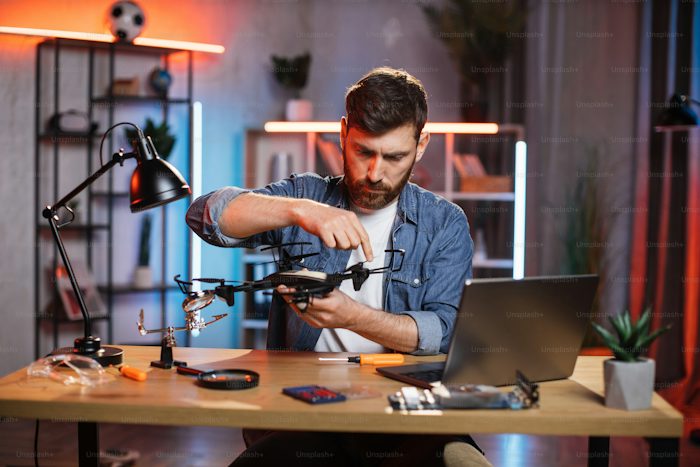Over the past decade, the use of unmanned aerial vehicles (UAVs), commonly known as drones, has seen a tremendous surge in popularity across various industries. Originally developed for military purposes, drones have rapidly found utility in sectors such as agriculture, construction, delivery services, photography, videography, and even recreational activities. With their versatile capabilities and cutting-edge technology, professional drones have the potential to revolutionize the way we live and work. In this article, we will explore the various applications of drones and their impact on society.
One of the most significant benefits of drones lies in their ability to autonomously carry out tasks that would otherwise be time-consuming, costly, or even dangerous. For instance, in agriculture, drones equipped with high-resolution cameras can efficiently survey and map fields, provide precision data on plant health, identify pest and disease outbreaks, and even spray pesticides precisely, reducing the need for manual labor and enhancing productivity. Such advanced imaging and mapping technologies like aerial LiDAR are also valuable in construction, enabling surveyors to assess sites, monitor progress, and create accurate 3D models, saving time, money, and improving safety.
Furthermore, drones have revolutionized the field of aerial photography and videography. In the past, capturing stunning aerial shots required expensive helicopter rentals, but now, with drones, anyone can obtain breathtaking imagery. Filmmakers and photographers can create videos with their cinematic shots, showcasing landscapes, real estate properties, or even capturing live events from unique perspectives. This accessibility has not only fueled creativity, but it has also opened up new opportunities for talented individuals to showcase their skills and earn a living.
Another sector that is benefitting from drone technology is logistics and delivery services. Companies like Amazon and DHL have been conducting successful trials for delivering packages by drones, promising faster and more efficient delivery options. With congested road networks and limited resources, drones offer a solution to transporting goods in challenging environments. Furthermore, in remote and rural areas, where traditional transportation infrastructure is lacking, drones can bridge the gap, ensuring essential supplies reach those in need. While the widespread adoption of drone delivery services is still in its infancy, the potential for this technology to transform the logistics industry is impossible to ignore.
In addition to their practical applications, drones have also become a source of recreation for countless enthusiasts. Piloting drones has rapidly grown into a popular hobby, with individuals using small, lightweight drones to perform tricks and capture stunning aerial footage for personal enjoyment. The rise of competitive drone racing has also attracted a dedicated community, competing in high-speed, adrenaline-pumping races, pushing the boundaries of technology and skill. These recreational uses not only offer entertainment but also serve as a gateway to developing skills in robotics, electronics, and aviation.
While the potential of drones is immense, it is essential to address some of the concerns associated with their use. Privacy and safety are two primary issues that need consideration. Drones equipped with cameras can invade personal privacy if not regulated properly, creating a potential for misuse. Similarly, the safe operation of drones near airports, populated areas, or critical infrastructure is paramount to avoid accidents or interruptions. Governments and regulatory bodies are actively working on frameworks to strike a balance between the potential benefits of drone technology and the need for safeguards.
Despite the vast potential, the widespread adoption of drones is not without challenges. Regulatory frameworks are still evolving, and concerns about privacy, safety, and security persist. Striking the right balance between harnessing the benefits of drone technology and implementing safeguards is crucial. Governments worldwide are working to establish clear guidelines and regulations to mitigate potential risks and ensure responsible drone use.
As drone technology continues to evolve, so do the possibilities for innovation. The integration of artificial intelligence (AI) and machine learning algorithms enhances the autonomy of drones, enabling them to perform more complex tasks with minimal human intervention. This opens up new frontiers in applications such as automated surveillance, infrastructure maintenance, and even autonomous drone deliveries.
The commercial drone industry is experiencing rapid growth, with startups and established companies alike investing in research and development. From developing more efficient battery technologies to creating specialized drones for niche industries, the race for innovation is driving the evolution of drone capabilities. As a result, the economic impact of the drone industry is expanding, creating job opportunities and contributing to economic growth.
The applications of drone technology extend to scientific research and exploration. Drones are being utilized in geological surveys, monitoring volcanic activities, and studying inaccessible landscapes. Their capacity to navigate challenging terrains makes them invaluable tools for researchers seeking to gather data in remote or hazardous environments. From studying wildlife behavior to collecting atmospheric data, drones facilitate scientific endeavors with unprecedented efficiency.
In the realm of infrastructure inspection, drones are proving to be game-changers. Traditional inspection methods often involve considerable risks for workers, especially when dealing with high structures such as bridges, towers, or power lines. Drones, equipped with high-resolution cameras and sensors, can perform detailed inspections without jeopardizing human safety. This not only reduces the risks associated with infrastructure maintenance but also allows for more frequent and thorough inspections, ens
In conclusion, drones have the power to transform various industries, offering innovative solutions for tasks that were once time-consuming, expensive, or unsafe. From agriculture to construction, logistics to entertainment, the versatility of drones is unrivaled. As technology continues to advance, it is incumbent upon us to harness the full potential of drones while addressing concerns regarding privacy and safety. Only then can we fully embrace this technology and realize the immense benefits it can bring to our society.

